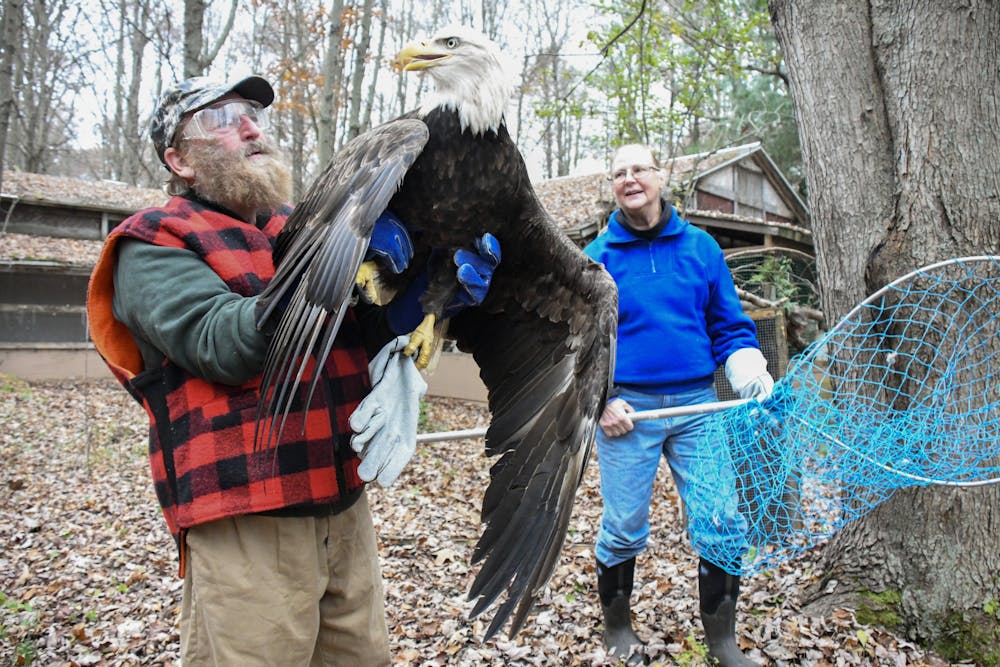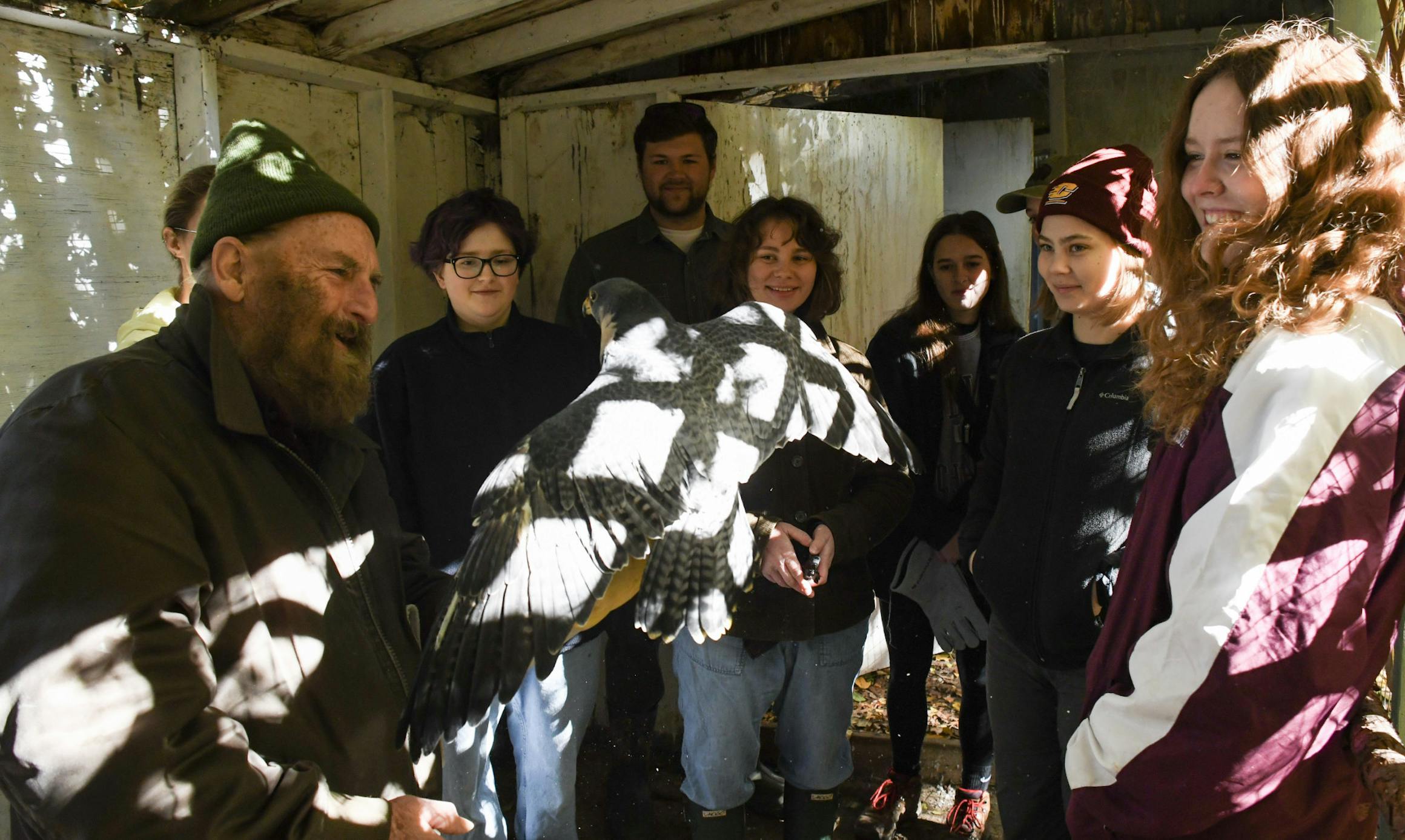From rescue to release
In Shepherd, a couple's lifelong passion for wildlife takes wing

Joe Rogers holds a bald eagle in preparation for its release while his wife, Barb Rogers, holds a net in case the eagle flies in the wrong direction Sunday, Nov. 5 at the Wildlife Recovery Association in Shepherd, Michigan. Joe and Barb are the founders of the WRA. (Ella Miller | CM Life)
SHEPHERD -- While driving along South Coleman Road off of M-20, you may notice a few birds flying overhead. As you make your way through the wooded area, you’ll pass a wetland and a row of power lines and you might spot a small wooden overlook in the distance perfect for birdwatching.
Tucked away in these woods is the Wildlife Recovery Association, and each of these things that you might easily pass by on your drive play an integral part in Barb and Joe Rogers’ lives.
Sharing a lifelong passion
Barb and Joe own the Wildlife Recovery Association, or WRA. It was established in 1979 with a goal of rehabilitating orphaned and injured birds of prey, providing educational outreach programs, and participating in research projects to support various species of birds.
For Barb, it began with starting Be Kind to Animals Club when she was in elementary school. She graduated from Western Michigan University and taught science for 28 years.
Joe graduated from Central Michigan University with a biology degree.
The two spent almost 30 years working on peregrine falcon reintroduction and monitoring in the Upper Peninsula.
“To me, it's so fascinating, and if I can show people, I feel like maybe they’ll pay attention and want to get involved in knowing what birds are like and appreciating them,” Barb said.
Barb and Joe travel around the state of Michigan giving educational programs at schools, nature centers, senior homes and other organizations. They bring program birds, which cannot be released back into the wild. These birds require extensive time and effort to become comfortable around humans.
“They have to be comfortable with you doing stuff and start to trust you before you can take them out around people at all because if they don’t build that trust, they just panic,” Barb said.
The Rogers use what they call the 100-time rule. They begin by standing outside the bird’s cage and talking to it roughly 100 times. Once the bird becomes comfortable, they stand inside the cage about 100 times. Then, they move through the steps of walking up to the bird, touching it and eventually holding it 100 times each.
“Some of them are very smart and they’ll pick up on it real quickly and be okay with it, and then some of them are really smart and don’t want anything to do with being handled,” Barb said.
Barb and Joe have noticed that nature is becoming less and less important in school curriculum. When creating their programming, they look at what concepts are taught at each grade level so they can cater it to each age, but they’ve found that nature is being taught and studied less than it used to be.
“The teachers can’t justify paying to have us come in,” Joe said.

Members of CMU's chapter of The Wildlife Society crowd around Joe Rogers as he holds Zorro the peregrine falcon Sunday, Oct. 22 at the Wildlife Recovery Association in Shepherd, Michigan. The Wildlife Society visits the WRA annually and helped trim Zorro's talons, which needs to be done on a routine basis. (Ella Miller | CM Life)
A labor of love
The educational programming the WRA puts on is not only a way for Barb and Joe to raise awareness and spread their passion, but also how they earn most of their money to run the organization. They do all of the cage building, painting, cleaning and maintenance themselves, with some help from volunteers, who are often CMU students.
“Every time we’d get $100 or more ahead, I’d go in and buy another load of wood. Then when we got enough wood, we’d just keep building (the cages) in sections,” Joe said.
Barb and Joe recently traveled from their home in Shepherd to give a program at Michigan Technological University in Houghton. They left at 1 a.m. and returned home around 11 p.m.
“We put so much of our own personal life into it,” Barb said.
Fighting for change
Just over a month ago, large high voltage transmission lines were routed through the wetland sanctuary owned by the Rogers family and the WRA. Barb and Joe fought the Michigan Electric Transmission Company (METC) on the issue for three years, due to the high number of bird deaths and ecosystem disruption that the lines cause.
“We were just sick about it,” Barb said. “They did everything they could to make it look like [the wetland] was not worth saving.”
Before the power lines were installed, the WRA conducted flight counts to determine the number of birds that cross the path where lines would go. They found that within the span of two hours per evening in October, an average of 1,800 birds moved through the area.
According to the U.S. Fish and Wildlife Service, 1% of birds that cross such power lines will collide. That means an average of 18 birds per evening would die due to the power lines running through the wetland.
In the WRA’s newsletter, Barb estimated that the lines would kill 1,600 birds this fall. Despite Barb and Joe bringing this information to METC and many options for alternate routes existing nearby, the lines were installed.
“We thought this should tell them that this is a flight path and they need to keep the power lines off here. They didn’t care,” Barb said. “Still, I wake up in the night, and I’m thinking about it. I’m thinking, 'how unfair.'”
Barb and Joe continue to educate about population loss and endangered species. Barb has a column in The Midland Daily News where she picks a species of bird to write about and includes her own photographs.
She said living in the wetland means everyday there is something special to photograph. She brings her camera with her everywhere.
“A lot of species are just going down dramatically and nobody seems to be that aware or concerned,” Barb said. “People don’t know, so how do I get that information out there? That’s when I decided I would start writing articles and try to get photos to people.”
Though the WRA is not currently taking in new rescues due to limited space and food costs, Barb and Joe continue to work to rehabilitate the many birds in their care. Recently, they were able to release a red-tailed hawk and a bald eagle.
As the birds soared off into the distant trees of the wetland, it was a clear sign of Joe and Barb’s hard work paying off.





